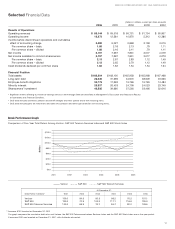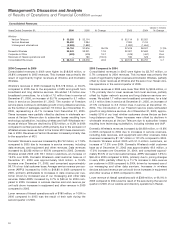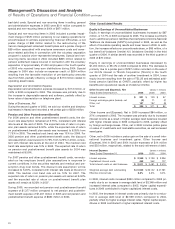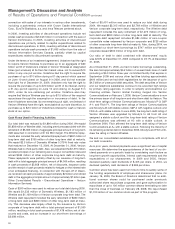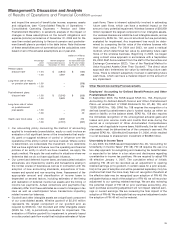Verizon Wireless 2006 Annual Report Download - page 25
Download and view the complete annual report
Please find page 25 of the 2006 Verizon Wireless annual report below. You can navigate through the pages in the report by either clicking on the pages listed below, or by using the keyword search tool below to find specific information within the annual report.
Minority Interest (dollars in millions)
Years Ended December 31, 2006 2005 2004
Minority interest $4,038 $3,001 $ 2,329
The increase in minority interest expense in 2006 compared to 2005,
and in 2005 compared to 2004 was attributable to higher earnings at
Domestic Wireless, which is 45% owned by Vodafone Group Plc
(Vodafone).
Provision for Income Taxes (dollars in millions)
Years Ended December 31, 2006 2005 2004
Provision for income taxes $2,674 $2,421 $ 2,078
Effective income tax rate 32.8% 28.7% 26.1%
The effective income tax rate is the provision for income taxes as a
percentage of income from continuing operations before the provi-
sion for income taxes. Our effective income tax rate in 2006 was
higher than 2005 primarily as a result of favorable tax settlements
and the recognition of capital loss carryforwards in 2005. These
increases were partially offset by tax benefits from foreign opera-
tions and lower state taxes in 2006 compared to 2005.
Our effective income tax rate in 2005 was higher than 2004 due to
taxes on overseas earnings repatriated during the year, lower for-
eign-related tax benefits and lower favorable deferred tax
reconciliation adjustments. Included in the provision of income taxes
in 2005 are capital gains realized in connection with the sale of our
Hawaii business, which resulted in the realization of tax benefits of
$336 million primarily related to capital loss carryforwards. This was
largely offset by a tax provision of $206 million related to the repatri-
ation of foreign earnings under the provisions of the American Jobs
Creation Act of 2004. The effective income tax rate in 2004 was
favorably impacted by the reversal of a valuation allowance relating
to investments, tax benefits related to deferred tax balance adjust-
ments and expense credits that are not taxable.
A reconciliation of the statutory federal income tax rate to the effec-
tive rate for each period is included in Note 16 to the consolidated
financial statements.
Discontinued Operations
Discontinued operations represents the results of operations of
TELPRI for all years presented in the consolidated statements of
income and Verizon Dominicana, Verizon Information Services and
Verizon Information Services Canada Inc. prior to their sale or spin-
off in December 2006, November 2006 and the fourth quarter of
2004, respectively.
In the second quarter of 2006, we announced our decision to sell
Verizon Dominicana and TELPRI and, in accordance with Statement
of Financial Accounting Standards (SFAS) No. 144, Accounting for
the Impairment or Disposal of Long-Lived Assets, (SFAS No. 144) we
have classified the results of operations of Verizon Dominicana and
TELPRI as discontinued operations. The sale of Dominicana closed
in December 2006 and, primarily due to taxes on previously
unremitted earnings, a pretax gain of $30 million resulted in an after-
tax loss of $541 million (or $.18 per diluted share).
We completed the spin-off of Idearc to our shareholders on
November 17, 2006, which resulted in an $8,695 million increase to
contributed capital in shareowners’ investment.
Discontinued operations also include the results of operations of
Verizon Information Services Canada Inc. prior to its sale in the fourth
quarter of 2004. The sale resulted in a pretax gain of $1,017 million
($516 million after-tax, or $.18 per diluted share).
23
Management’s Discussion and Analysis
of Results of Operations and Financial Condition continued
Income from discontinued operations, net of tax decreased by $611
million, or 44.6% in 2006 compared to 2005. This decrease was pri-
marily due to the after-tax loss recorded in 2006 on the sale of Verizon
Dominicana, partially offset by cessation of depreciation on fixed
assets held for sale. Income from discontinued operations, net of tax
decreased by $562 million, or 29.1% in 2005 compared to 2004. The
decrease was primarily driven by the after-tax gain recorded on the
sale of Verizon Information Services Canada Inc. in 2004.
Cumulative Effect of Accounting Change
In December 2004, the Financial Accounting Standards Board
(FASB) issued SFAS No. 123(R), Share-Based Payment, (SFAS No.
123(R)) which revises SFAS No. 123, Accounting for Stock-Based
Compensation (SFAS No. 123). SFAS No. 123(R) requires all share-
based payments to employees, including grants of employee stock
options, to be recognized as compensation expense based on their
fair value. Effective January 1, 2003, we adopted the fair value
recognition provisions of SFAS No. 123, using the prospective
method (as permitted under SFAS No. 148, Accounting for Stock-
Based Compensation – Transition and Disclosure (SFAS No. 148)) for
all new awards granted, modified or settled after January 1, 2003.
Under the prospective method, employee compensation expense in
the first year is recognized for new awards granted, modified, or set-
tled. The options generally vest over a term of three years, therefore,
the expenses related to stock-based employee compensation
included in the determination of net income for 2006, 2005 and 2004
are less than what would have been recorded if the fair value method
had been applied to previously issued awards.
Effective January 1, 2006, we adopted SFAS No. 123(R) utilizing the
modified prospective method. SFAS No. 123(R) requires the meas-
urement of stock-based compensation expense based on the fair
value of the award on the date of grant. Under the modified prospec-
tive method, the provisions of SFAS No. 123(R) apply to all awards
granted or modified after the date of adoption. SFAS No. 123(R) is
supplemented by Staff Accounting Bulletin (SAB) No. 107, “Share-
Based Payments” (SAB No. 107). This SAB, which was issued by the
Securities and Exchange Commission (SEC) in March 2005,
expresses the views of the SEC staff regarding the relationship
between SFAS No. 123(R) and certain SEC rules and regulations. In
particular, this SAB provides guidance related to valuation methods,
the classification of compensation expense, non-GAAP financial
measures, the accounting for income tax effects of share-based
payment arrangements, disclosures in Management’s Discussion
and Analysis subsequent to adoption of SFAS No. 123(R), and inter-
pretations of other share-based payment arrangements. We also
adopted SAB No. 107 on January 1, 2006.
We recorded a $42 million cumulative effect of accounting change
as of January 1, 2006, net of taxes and after minority interest, to rec-
ognize the effect of initially measuring the outstanding liability
awards (VARs) of the Verizon Wireless joint venture at fair value uti-
lizing a Black-Scholes model. We do not expect SFAS No. 123(R) to
have a material effect on our consolidated financial statements in
future periods.






